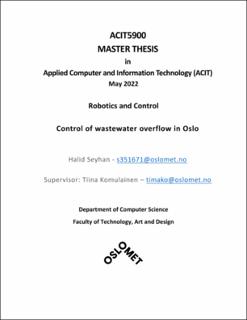| dc.description.abstract | Purpose of this study was to obtain an accurate model of Oslo Sewer Network and to develop SISO and MIMO control strategies to minimize overflows. In Oslo, water quality in the fjord is a major concern. Extreme rain events cause untreated water spill to the Oslo fjord from the sewer network. Oslo Municipality is aiming to cut the overflow to Oslo fjord by 2035 and it is expected that with the climate change, Oslo region will face more extreme and frequent rain events in the future. Therefore, implementation of a real-time control strategy for the sewer network can contribute to have a cleaner water in the fjord. In this study, after a literature review on RTC and urban drainage systems, a model of the Oslo sewer network has been created in MATLAB/Simulink (Inc., 2021) environment. Second, SISO and MIMO control strategies are developed with the purpose of minimizing overflows. Third, historical rain events with varying intensity have been simulated and the performance of the control strategies have been tested with and without a real time optimization based on the weather forecast data. Accordingly, Research questions are: How much real-time control can reduce the overflows? How well SISO and MIMO control strategies perform in comparison? And how much will the real-time optimization with forecast data will improve their performances? | en_US |
